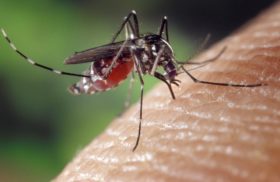
Natural ecosystems should be, and can be, our friend. We need bees, ants and other pollinators to pollinate our food such as fruits and vegetables; we also need them to pollinate our flowers. We even have insects that eat our decaying matter, including some not so pleasant things such as our left over foods, or even human waste. When I studied entomology in college, I was enamored by the number of benefits that the wide array of insects provide. But with all good things, comes some bad, and unfortunately, some of the insects out there tend to be harmful to us as well. Such as mosquito’s that can spread diseases, or wasps and horseflies that offer a big painful bite.
It’s a conundrum: we need insects, but we don’t want them on us, and for good reason. We want to continue eating delicious foods pollinated by insects, but we don’t want mosquito’s, cockroaches, gnats, or even houseflies. And we especially don’t want to get bit, or worse yet, suffer from a disease such as malaria, yellow fever, dengue fever, and countless many others out there.

Efforts to eradicate mosquito’s in endemic areas have not gone unnoticed, and have been fairly successful. But many people are not aware of what these efforts are, nor what long term affects on our planet (and ourselves), these have.
Truth be told, we don’t really know everything that is sprayed to control insects, although the science is improving. Cures have been developed for many of the diseases that are caused by insects. And efforts to address problems by understanding the life-cycle of harmful insects have also had success by means of prevention (by preventing the insect from developing to adult reproductive stage). Unfortunately, these efforts are done via means that can also affect other aspects of our lives and our environment, many of which we don’t yet fully understand.
For example, when DDT first started to be used in large quantities, no one knew that the chemical would also harm birds (and human health). This occurs by a long process that affects the birds’ calcium metabolism that results in a thin egg shell, which in turn prevents the developing bird to mature to break out of the shell. Fortunately, the ecological harm of DDT was brought to public attention by Rachel Carson’s book Silent Spring. DDT almost wiped out North American bald eagle populations. While DDT has been banned in many countries, it is still touted by some as a product to use to protect yourself.
And while DDT worked well as an insect repellent at first, more recent studies have shown that insects have adapted to it, and it is no longer as effective as an insect repellent. Yet it is still just as harmful to human health and the natural ecology.
DEET is another problematic chemical. While it is no where near as bad as DDT, there are still human health concerns associated with its use. For example, topical DEET use has been associated with neurological pathologies such as siezures (especially in children),1,2 insomnia, and cognitive impairment.3 In addition, DEET can act as a solvent on some plastics and rayons, along with other materials, so it seems that it would likely also cause damage to human skin. In fact there is a variety of evidence that DEET can cause skin problems ranging from mild irritation to severe ulcers, depending on concentration.4 So while DEET is an effective insect repellent, and it probably won’t kill you, it is also not completely safe for human health, and it may have long term unintended environmental or ecological consequences.

On a related topic, studies are also starting to show the longer term consequences that pesticides are having on plants. When grown in pesticide treated environments, plants lost their natural defenses against insects in just a few generations. For example, this study on the evening primrose plant show just that.
Despite the research that is slowly emerging, not only are chemicals still being used in vast amounts, but also spread by means such as airplanes to cover larger areas – referred to as aerial spraying. This means where the chemical ends up cannot be fully controlled. Chemicals such as Naled, while already banned in regions such as the EU, are still being used in other countries, including parts of the US, such as in Florida to control Zika spread.
My goal is not to bring up a controversial topic, but rather, bring awareness that our use of insecticides has a price to pay. In nature, as in most aspects of life, there is no such thing as a free lunch. While mosquito control is a huge topic of importance, and I would never question the importance of disease prevention, I am trying to point out the importance of being aware that these methods have consequences. Consequences for the planet, and for human health.
Biological systems, whether an ecosystem or an organismal system like human health, have aspects of both resilience and fragility. Sometimes biological systems can compensate for chemical insults, and other times chemical exposures prove to be catastrophic. The tricky part is, we never know which chemicals fall into which category unless a lot of scientific research is conducted (for example, human and environmental toxicology). And more often than not, that research is only done after the damage has been done. This does not seem to be a wise or responsible approach, given that “an ounce of prevention is worth a pound of cure”. On a related topic, the EPA and FDA require very little (if any) environmental or human toxicology research before new pesticides, herbicides, and fungicides can be brought to market.

While studies show that certain concentrations of these chemicals are relatively safe, the truth is, we don’t really know how much of these chemicals we are actually exposed to. Since not only are we spraying these on ourselves, but are also surrounded by them, having these chemicals sprayed in our environment. In the long run, we don’t really know how this will affect human health, or our planet.

This is why we developed an all natural insect repellent. It is not intended to control mass populations of mosquitoes or other nasty insects. It is intended to confuse insects’ olfactory cells, thus making insects think you’re not really a tasty meal, but perhaps a noxious weed, a tree, or something other than a delicious drink of human blood. Confusing insects in this way is actually quite effective in preventing them from landing on you or biting you. So it provides refuge from all the insects around you, while not harming you, the insects, or our planet in the process.
I first tested our Refuge insect repellent a couple years ago when I traveled to Central America. I used it in conjunction with some of our early versions of our Shield Sunscreen. I am glad to report that after two weeks of travel in insect infested Central America, the only bite that occurred, was by a mosquito in my hotel room that went unnoticed until after I showered and washed off the sunscreen and insect repellent. Granted, the mosquito populations have become largely controlled in Central America (by a variety of chemicals that I would rather not be exposed to), but the mosquitos are still certainly a problem, especially when away from the major cities.
Other bugs were also a concern. For instance, one evening I wore our Refuge insect repellent while having a wonderful dinner outside on the patio of our hotel room, and Rob decided to be tough and wore nothing. Upon coming inside, we discovered he was covered in small bites, only to learn that there are bugs called “No-see-ums“. Perfect name I must admit, because we did not see or feel them. But I didn’t have a single bite, and Rob was covered. While I won’t claim our insect repellent is 100% full-proof, as it is not, but our unintentional experiment demonstrates that it is effective.
While I’m not fond of bug bites, I am fond of insects in general. They are important to our ecology, and our way of life when it comes to food production, so I do not wish to harm them. Which is why I will continue selling our all natural insect repellent. Even though it’s not always 100% effective, it does work quite well and is completely safe to use. Just make sure that you cover yourself thoroughly, and use other natural measures for prevention, in conjunction with our Refuge insect repellent.
For Health,
Tober
References:
1 Osimitz TG, Murphy JV, Fell LA, Page B. Adverse events associated with the use of insect repellents containing N,N-diethyl-m-toluamide (DEET). Regul Toxicol Pharmacol. 2010;56(1):93-9.
2Briassoulis G, Narlioglou M, Hatzis T. Toxic encephalopathy associated with use of DEET insect repellents: a case analysis of its toxicity in children. Hum Exp Toxicol. 2001;20(1):8-14.
Nature's Complement is a participant in the Amazon Services LLC Associates Program, an affiliate advertising program. If you purchase products on Amazon through any of our affiliate links, we get a small percentage of the transaction, at no extra cost to you. We spend a lot of time writing the articles on this site, and all this information is provided free of charge. When you use our affiliate links, you support the writing you enjoy without necessarily buying our products. (However we would appreciate if you would do that too!) Thank you for helping to support our work, however you choose to do so.
These statements have not been evaluated by the Food and Drug Administration. This information and/or products are not intended to diagnose, treat, cure or prevent any disease.



